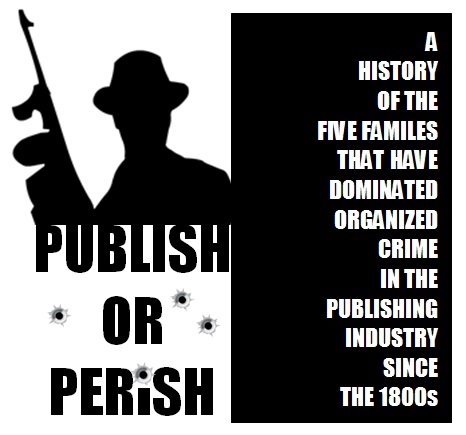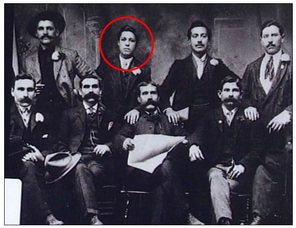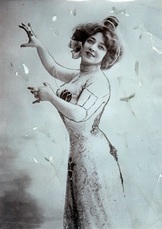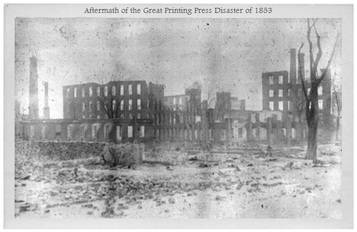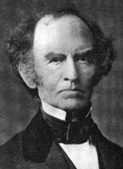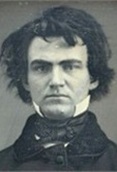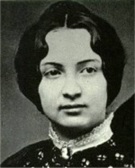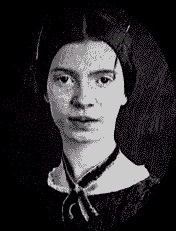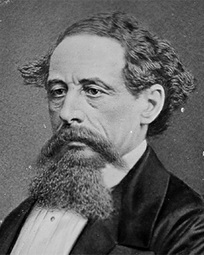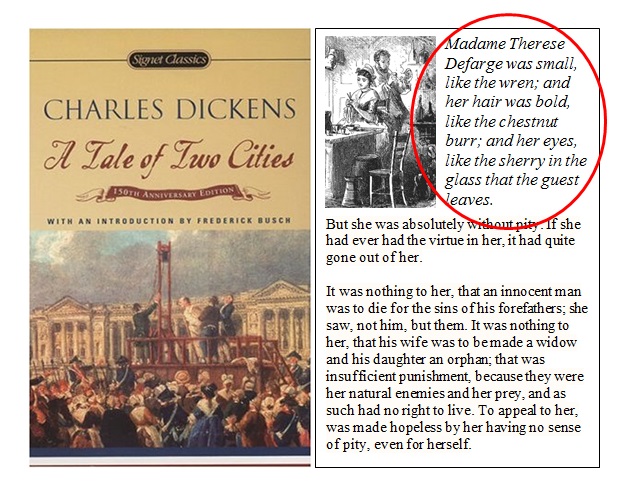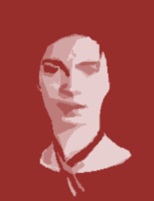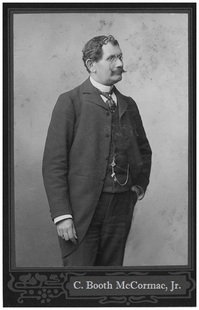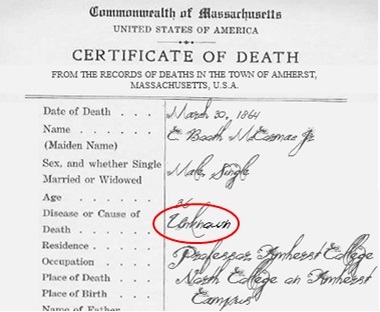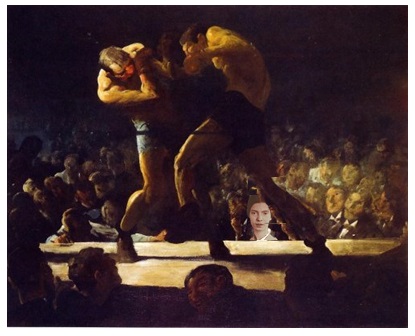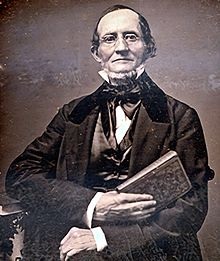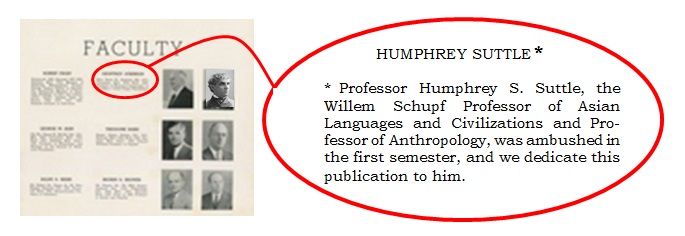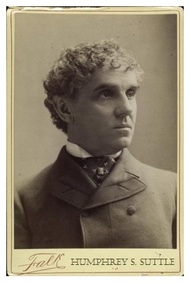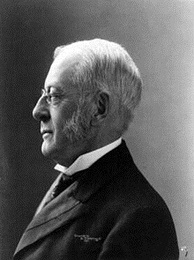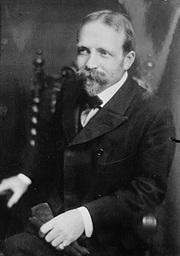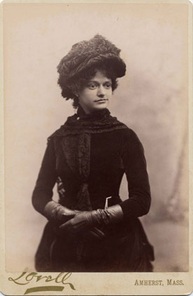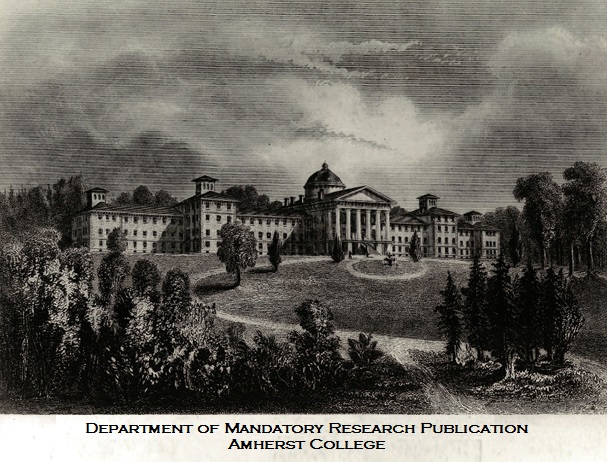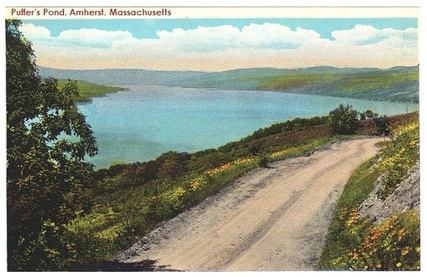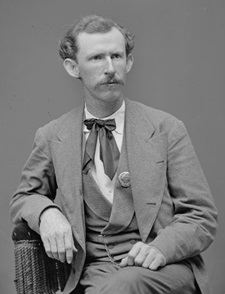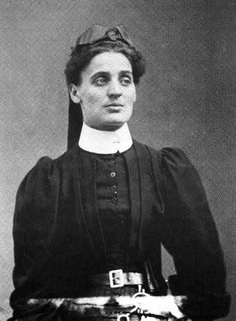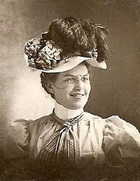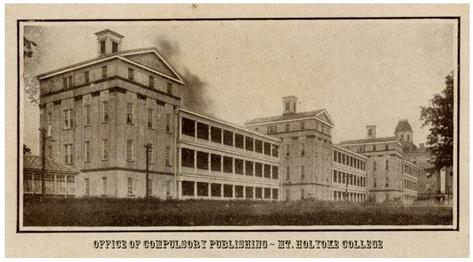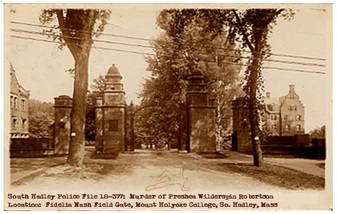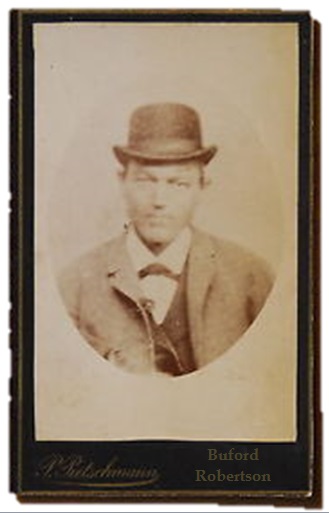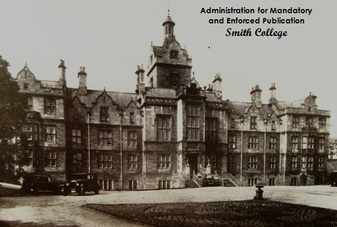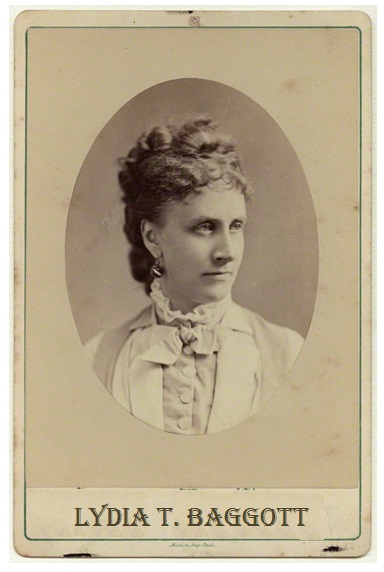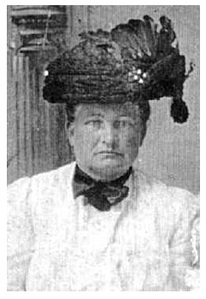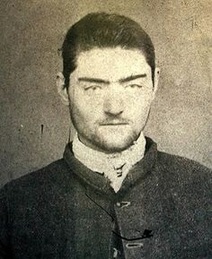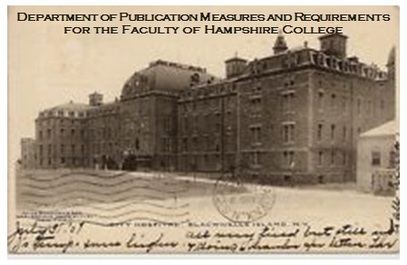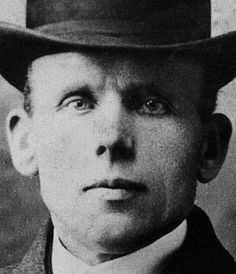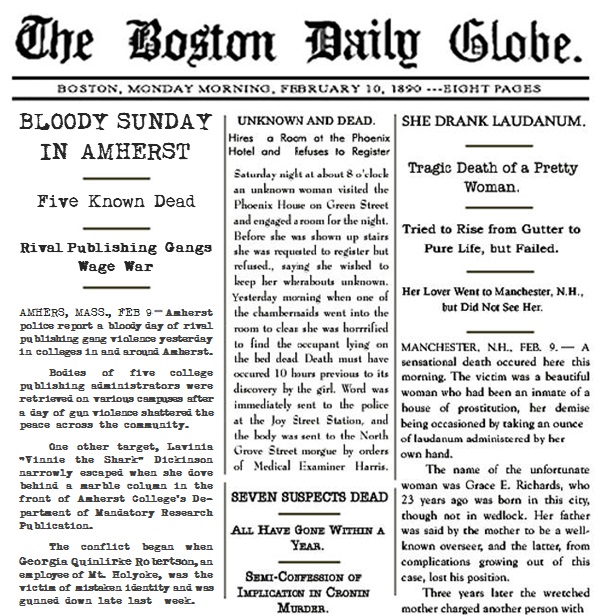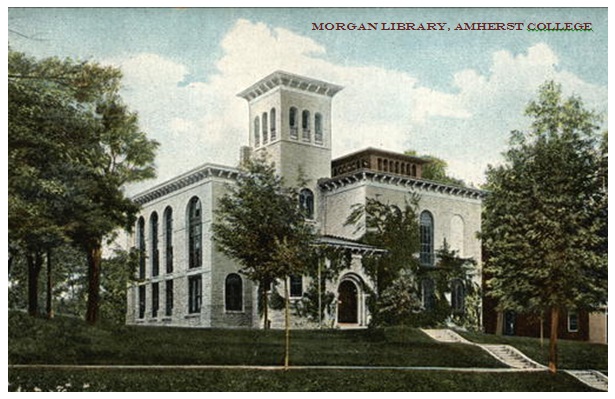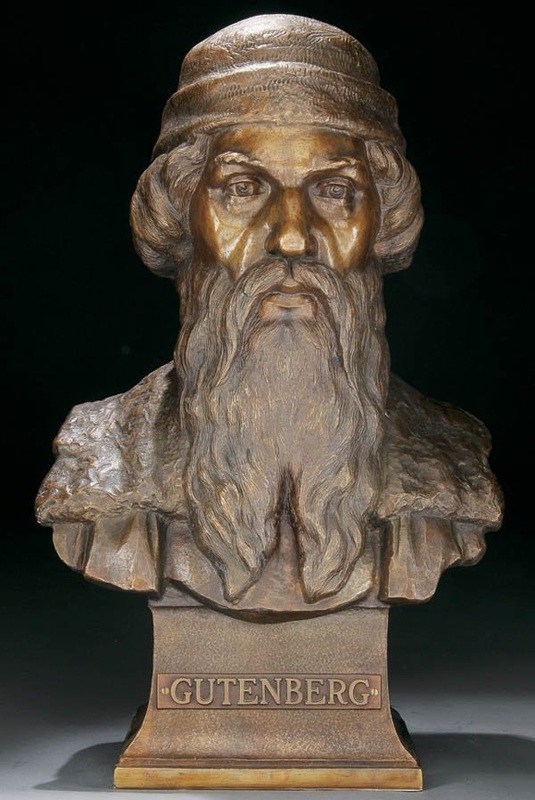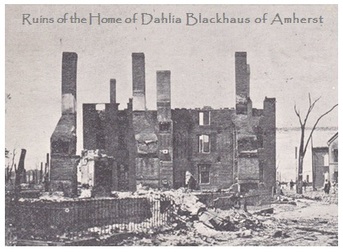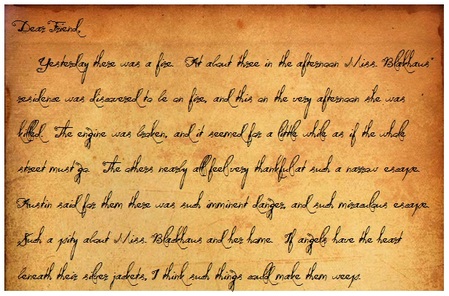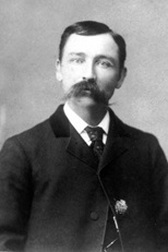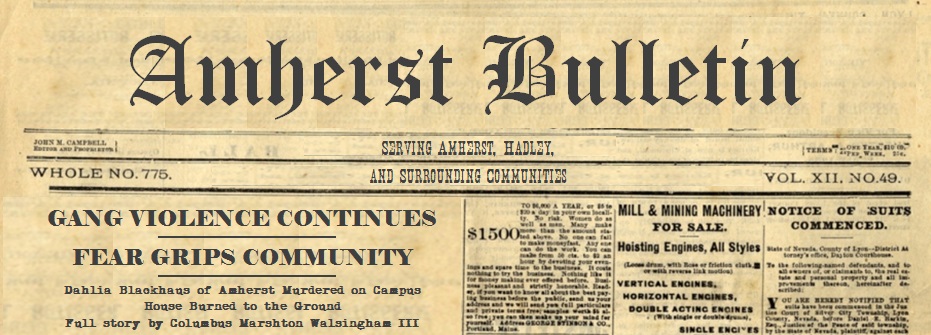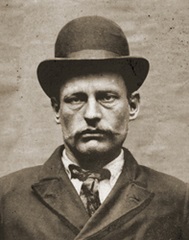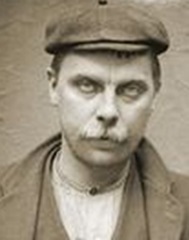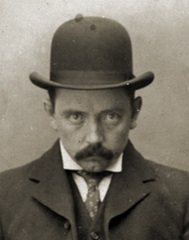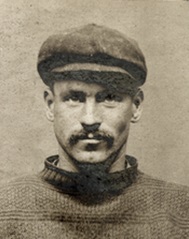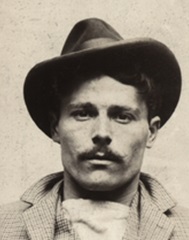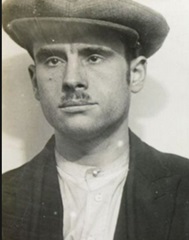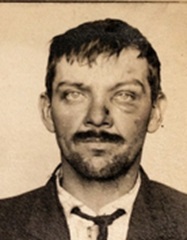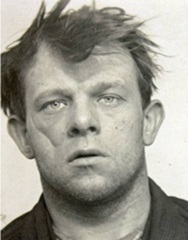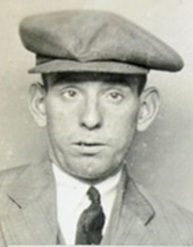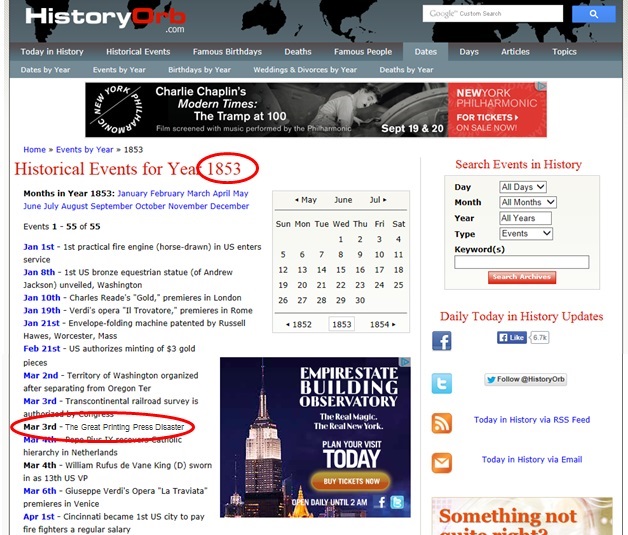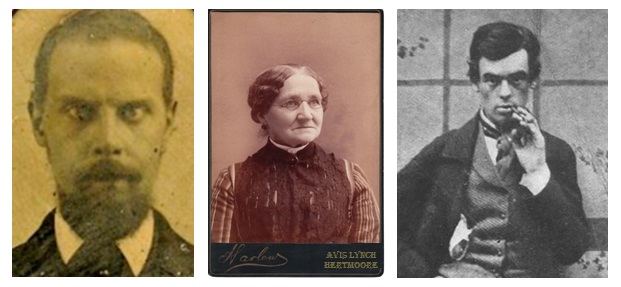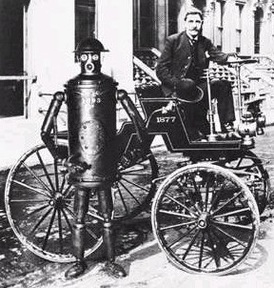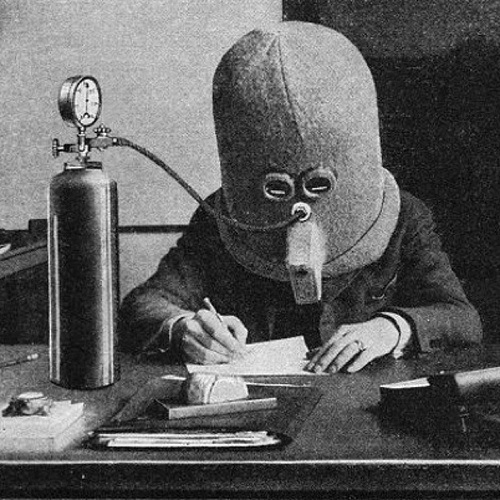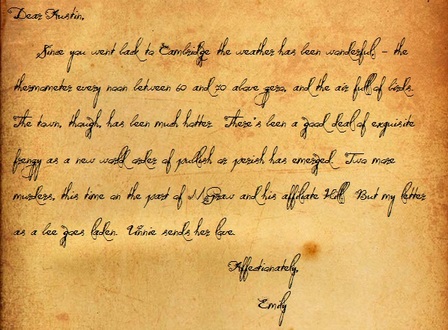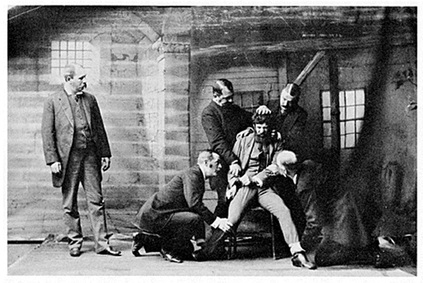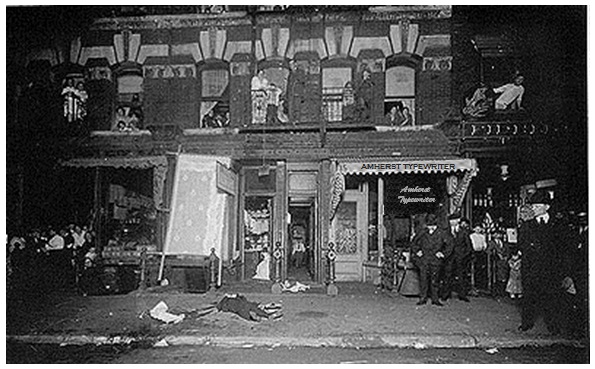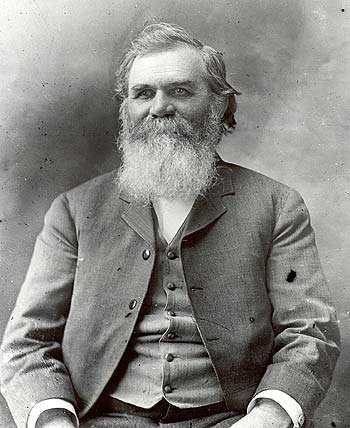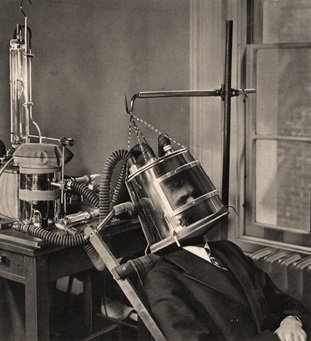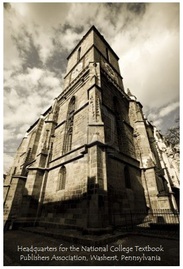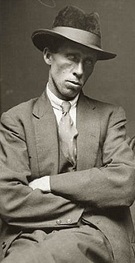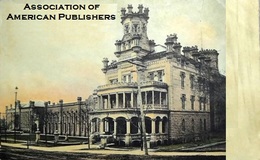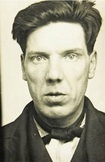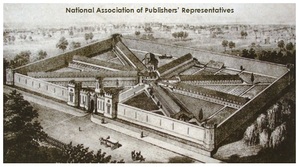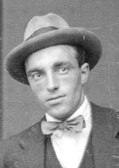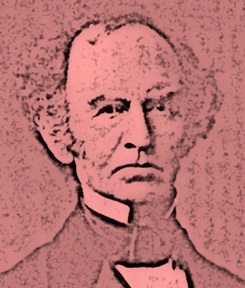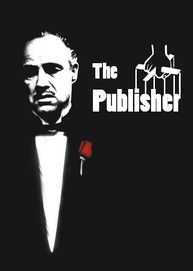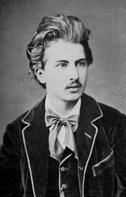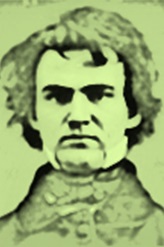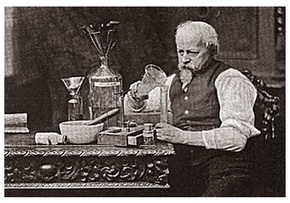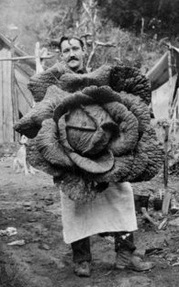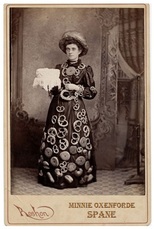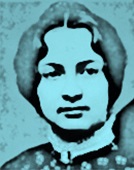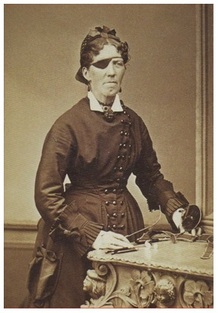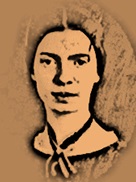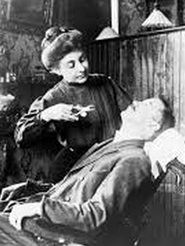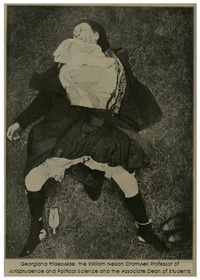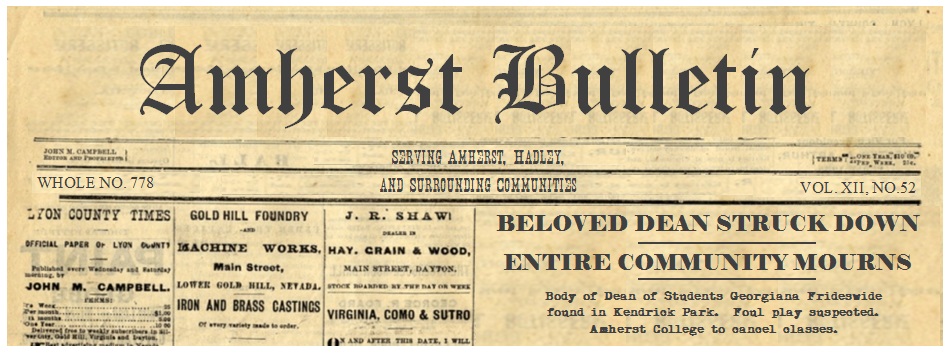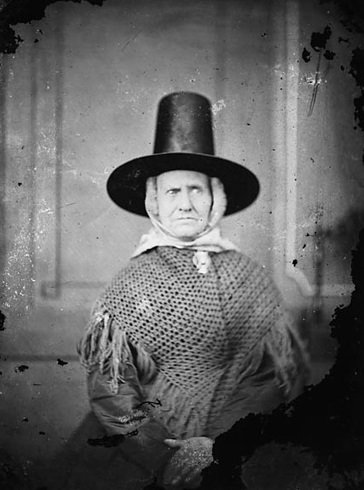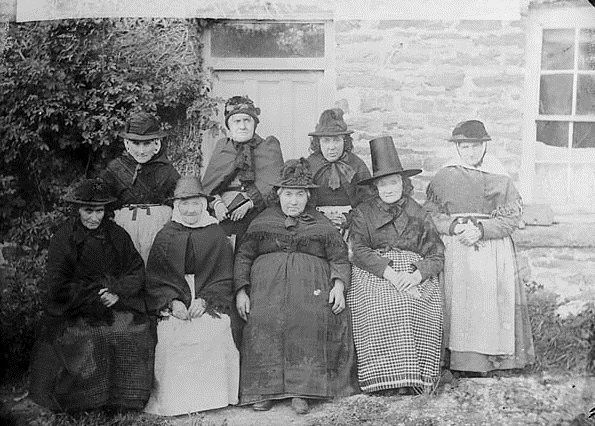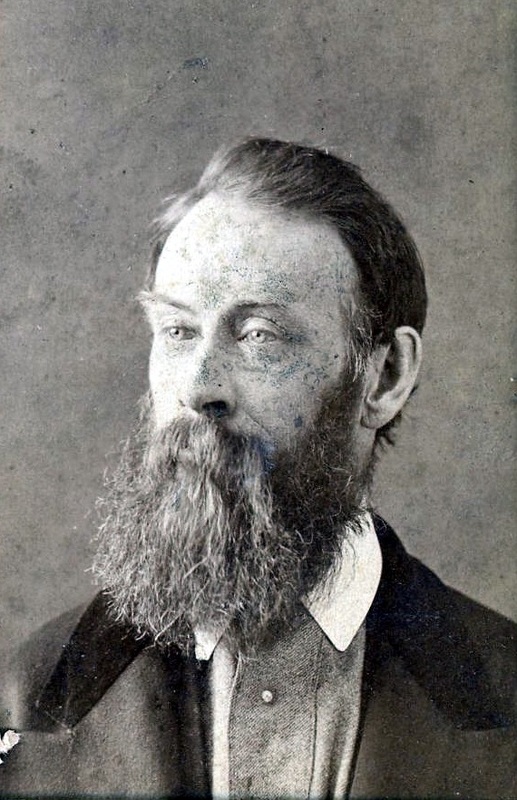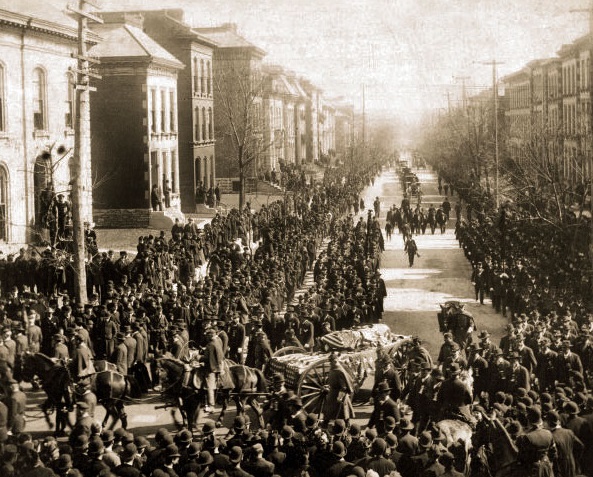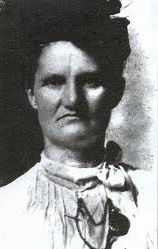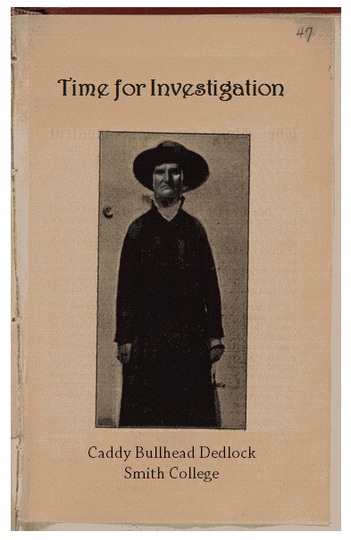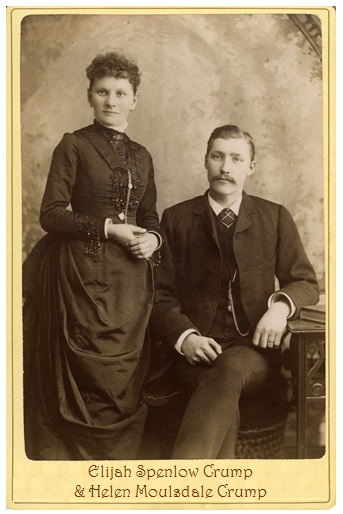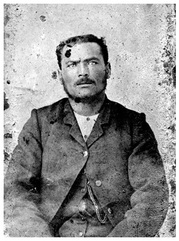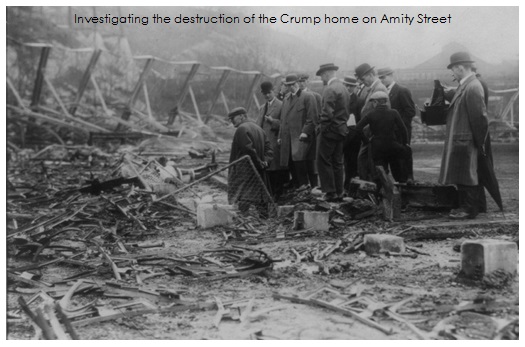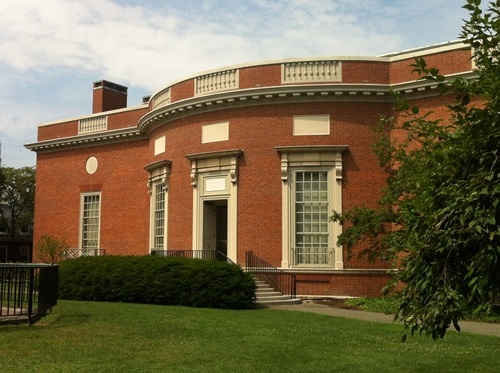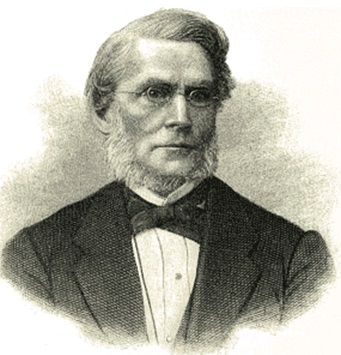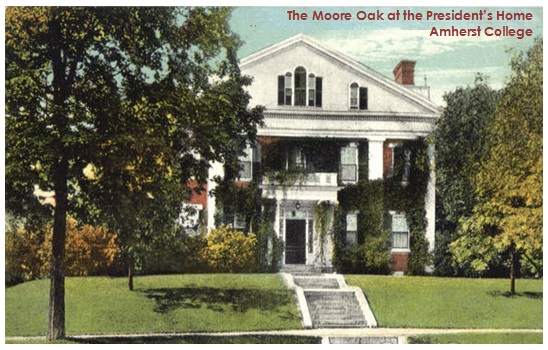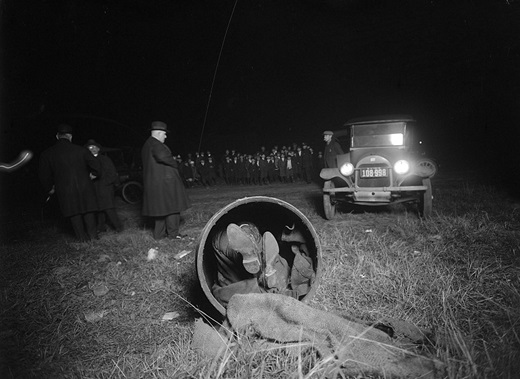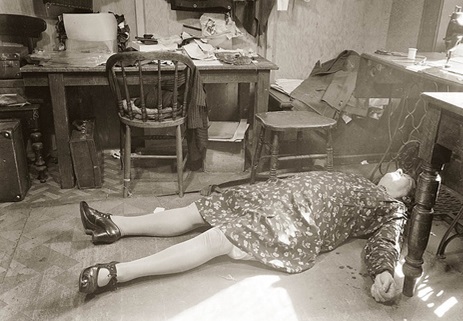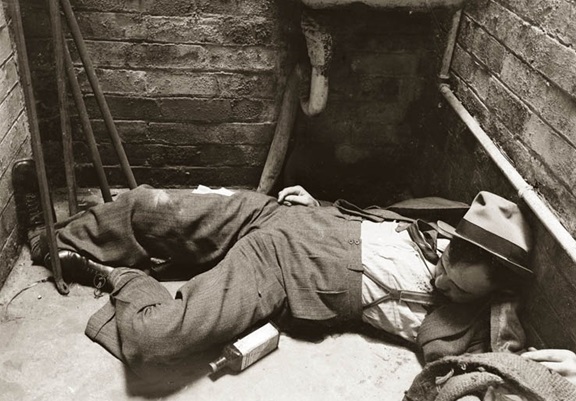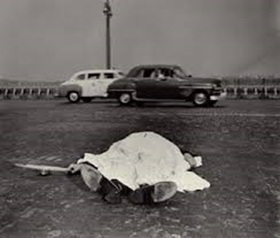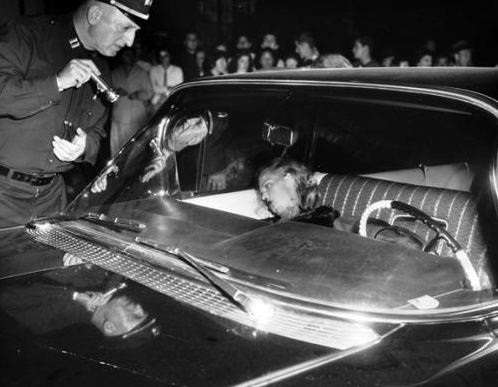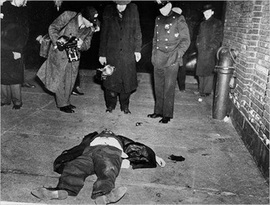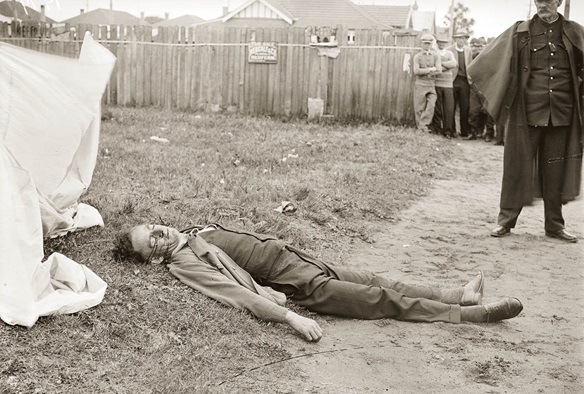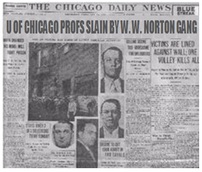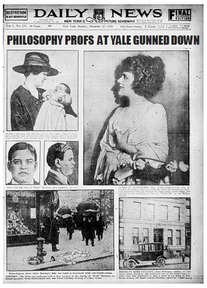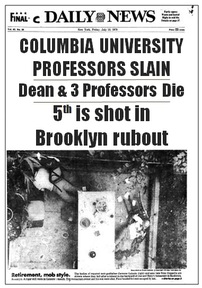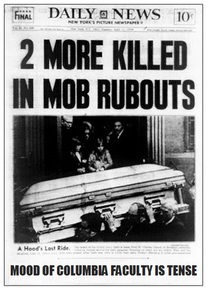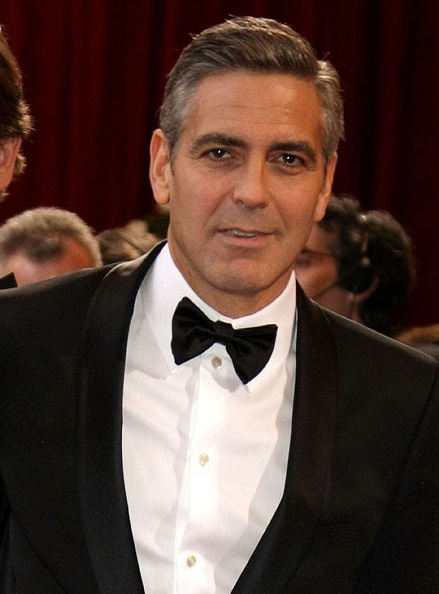JULY 2014PUBLISH OR PERISHThe Five Families of the publishing industry originated in the mid-1800s out of the lower east side of Amherst, Massachusetts, from the "publish or perish" gangs of Amherst College, Hampshire College, Mount Holyoke College and Smith College (Edward Dickinson, Emily Dickinson's father, was a consiglieri to one of the front bosses to Don Vito Houghton).
This July we will tell the untold story of the Five Families in the cut-throat world of academia:
Houghton Mifflin W. W. Norton Simon & Schuster Little Brown McGraw Hill |
July 1: The Cut-Throat "Publish or Perish" World of Academia
In the mid-1800s, Wesley Warwick Norton (the son of publisher William Wycuff "W. W." Norton) was to marry Anne Thology. Ms. Thology was the daughter of Sophronia Brinkley Houghton (of the Houghton publishing dynasty) and B. Caultin Thology. The result of this marriage would have been the merger of two of the most powerful of the five major publishing families.
However, the marriage never took place due to what is now referred to as "the Great Printing Press Disaster of 1853." As a result, the Five Families continue to battle in the cut-throat "publish or perish" world of academia at colleges and universities across the U.S.
However, the marriage never took place due to what is now referred to as "the Great Printing Press Disaster of 1853." As a result, the Five Families continue to battle in the cut-throat "publish or perish" world of academia at colleges and universities across the U.S.
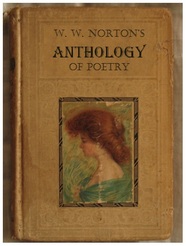
Pictured at the left: The one positive outcome from the "printing press disaster" and cancelled wedding: Wesley Warwick Norton took Anne Thology's idea of combining poems from various poets into a single volume. Prior to that, all books of poetry featured the works from a single poet. After Anne's death, though, W. W. Norton published a single text which included all of Anne's favorite poems, and he named the book after his lost love, "Anthology."
July 2: The Dickinsons of Amherst
The Dickinsons of Amerherst played a major role in helping to establish the Houghton-Mifflin family as a major kingpin in the "publish or perish" world of academia.
|
Pictured at the far left: Edward Dickinson, Emily Dickinson's father,
was a consiglieri to one of the front bosses to Don Vito Houghton.
Pictured in the center: Austin “The Squire” Dickinson, Emily Dickinson’s brother, was a capregime, or capo, for the Houghton family. Pictured at the left: Lavinia "Vinnie the Shark" Dickinson, Emily's sister, rose in the ranks of the family to a leadership position. |
|
What was Emily Dickinson's role in "the family business"? Was she a soldier? A savior? A calculating spectator or an innocent bystander? We will examine Emily Dickinson's role in the family tomorrow, though this anecdote will shed some light on her part:
Charles Dickens once had a rather heated conversation with Emily Dickinson about his grievances with the many impediments and frustrations he experienced with publishers, and Dickinson's comments -- that publishers were a "close knit family"-- inspired him to create the character of Madame Defarge in A Tale of Two Cities. Later, Emily Dickinson used Dickens' description of Defarge to describe herself in a letter to her mentor Thomas Wentworth Higginson. |
July 3: Emily Dickinson's Role in the "Family Business"
|
"'Secrets' is a daily word," wrote Emily Dickinson, and her family shared in many "secrets" when it came to the "publish or perish" culture of academia.
One such secret Emily Dickinson took to her grave was her role in the "family business." Her position and responsibilities within the "business" remain a mystery and are still being debated to this day -- although many clues can be found in her poetry. |
|
Shortly after C. Booth McCormac, Jr, was found dead in the North College building on the campus of Amherst College, Emily Dickinson wrote the following:
How ruthless are the gentle – How cruel are the kind – God broke his contract to his Lamb To qualify the Wind – McCormac was a Professor of Geological Sciences & Geophysics at the college, and at the time of his death he had not published any articles or books in five semesters. His death certificate, shown at the far right, listed his cause of death as "Unknown." |
July 4: Soldier? Savior? Or Silent Observer?
Did Emily Dickinson know about the "family business"? Research -- and her poetry -- indicates that she did, and perhaps she even participated. In one poem she wrote, "The mob within the heart / Police cannot suppress," and in another she wrote, "My life had stood -- a loaded gun."
However, some records indicate that targets of the family often appealed to Emily Dickinson, known as the "Belle of Amherst," for sympathy and help. If Emily stepped in to save someone, they were said to have been "saved by the Belle." As a result, the saying "saved by the Belle" entered our lexicon, and it is often used in sports, particularly boxing.
However, some records indicate that targets of the family often appealed to Emily Dickinson, known as the "Belle of Amherst," for sympathy and help. If Emily stepped in to save someone, they were said to have been "saved by the Belle." As a result, the saying "saved by the Belle" entered our lexicon, and it is often used in sports, particularly boxing.
|
Pictured at the right: Hargate Finnahan was the Esther Cloudman Dunn Professor Emeritus of English Language and Literature at Smith College. His journal entries indicate that he was targeted by the Dickinson family for "neglectful publishing," and he appealed to Emily Dickinson for mercy and forgiveness.
Professor Finnahan was "saved by the Belle," and shortly thereafter, Emily Dickinson penned the following poem: It came his turn to beg – The begging for the life Is different from another Alms 'Tis Penury in Chief – I scanned his narrow realm I gave him leave to live Lest Gratitude revive the snake Though smuggled his reprieve |
July 5: Emily Dickinson -- Clever Mastermind?
Although some potential victims turned to Emily Dickinson, the Belle of Amherst, in hopes of being "saved by the Belle," research indicates that Dickinson participated knowingly and completely in the "family business." In one of her poems she wrote, 'The right to perish might be thought / An undisputed right," so with many of her victims, she showed little to no mercy at all.
|
The "subtle name" in the lines above refers to Humphrey S. Suttle, the Willem Schupf Professor of Asian Languages and Civilizations and Professor of Anthropology at Amherst College. Suttle had not published any of his research in over two years, and he was mysteriously ambushed during the first semester of classes in the 1866-67 school year. His body was riddled with bullets.
That year, the Amherst College yearbook, the Olio, was dedicated to him , and an asterisk appeared after his name on the faculty page of the book. Shortly thereafter, Dickinson wrote the poem above, and stated, "and now against his subtle name there stands an asterisk." Pictured at the right above: The Olio's dedication to Humphrey Suttle. Picture at the right below: Humphrey S. Suttle |
July 6: The Emergence of the "Family" at Amherst College
In the early 1880s, Austin "The Squire" Dickinson, the treasurer of Amherst College, became irritated if not outraged at the dominance of and the strong-arm tactics employed by Harvard Publishing. He began to suspect that lackeys of Harvard President Charles William Eliot had infiltrated Amherst College's Department of Mandatory Research Publication, so he hired an undercover agent named David Peck Todd.
David Peck Todd posed as a professor of astronomy and director of the observatory at Amherst College, His wife, Mabel Loomis Todd, also served as an internal mole. The Dickinson "family" even developed an elaborate ruse involving an affair between Mabel Loomis Todd and Austin Dickinson which allowed her to visit the Dickinson homes, the Homestead and the Evergreens, without anyone suspecting her actual involvement within the "publish or perish" underground.
David Peck Todd posed as a professor of astronomy and director of the observatory at Amherst College, His wife, Mabel Loomis Todd, also served as an internal mole. The Dickinson "family" even developed an elaborate ruse involving an affair between Mabel Loomis Todd and Austin Dickinson which allowed her to visit the Dickinson homes, the Homestead and the Evergreens, without anyone suspecting her actual involvement within the "publish or perish" underground.
|
Pictured at the left: Charles William Eliot, the president of Harvard University from 1869 - 1909. Eilot was ruthless when it came to dealing within the "publish or perish" culture in academia.
Pictured in the center: David Peck Todd, an uncover agent at Amherst College's Department of Mandatory Research Publication. Pictured at the far right: Mabel Loomis Todd, another undercover agent at Amherst College. Her cover involved an elaborate ruse about an affair between her and Austin "the Squire" Dickinson. |
July 7: A Shift in the Balance
|
It wasn't long after David Peck Todd and Mabel Loomis Todd began their work as undercover agents in Amherst College's Department of Mandatory Research Publication when their work began to pay off.
In a matter of weeks Mabel Loomis Todd was able to expose Chester Oakshott Puffer as an infiltrator from Harvard Publishing. Puffer was sent to Amherst College by Harvard President Charles William Eliot to delay any publications from Amherst College faculty so that any and all Harvard research would be published first. In that way, Harvard would continue to dominate in any advances in the world of academia. Shortly after Mabel Loomis Todd divulged Puffer as a Harvard spy, Puffer was found drowned at Factory Hollow Pond, now called Puffer's Pond, near Amherst. |
Pictured above: Chester Oakshott Puffer, a Harvard spy at Amherst College.
Pictured at the left: Factory Hollow Pond was later renamed Puffer's Pond after Puffer's body was found at the bottom of the pond. |
|
Pictured at the right: Shortly after Puffer's bloated body was pulled from Factory Hollow Pond (now Puffer's Pond), Emily Dickinson wrote these lines -- and the power balance in the world of publishing shifted from Harvard University in Cambridge, Massachusetts, to Amherst College in Amherst, Massachusetts. |
Drowning is not
so pitiful
As the attempt to rise Three times, 'tis said, a sinking man Comes up to face the skies, And then declines forever To that abhorred abode, Where hope and he part company -- |
July 8: The Amherst "Publish or Perish" Gang Wars Erupt
|
The undercover work of David Peck Todd and Mabel Loomis Todd shifted the balance of power in the world of publishing from Boston and Cambridge to Amherst. However, when Amherst College began to emerge in a position of power, other Amherst colleges began to respond.
Pictured at the right: Zona F. McDermitt, head of Mt. Holyoke's Office of Compulsory Publishing. In order to bring Mt. Holyoke to the forefront of research publishing, she arranged for the murder of Georgia Quinlirke Robertson, the Marilyn Dawson Sarles Professor of Life Sciences and Professor of Chemistry, for failing to publish over the course of three tri-mesters. Pictured at the far right: Preshea Wilderspin Robertson, who was gunned down at the Fidelia Nash Field Gate at Mt. Holyoke when her assailants mistook her for Georgia Quinlirke Roberston. |
|
At the right: When the case of the mistaken identity was revealed, Emily Dickinson wrote the following lines in honor of Preshea Robertson.
Preshea Robertson's husband, Buford Robertson, was the head of Smith College's Administration for Mandatory and Enforced Publication. When he learned of his wife's murder, he swore an oath of vengeance on Zona McDermitt, and the Amherst "Publish or Perish" Gang Wars erupted. |
We never know we go when we are going –
We jest and shut the Door – Fate – following – behind us bolts it – And we accost no more – |
July 9: "Bloody Sunday" in Amherst
|
Buford Robertson (pictured at the far left) was the head of Smith College's Administration for Mandatory and Enforced Publication (pictured at the left). When he realized that his wife Preshea Wilderspin Robertson had been the victim of a hit ordered by Zona McDermitt and was murdered in a case of mistaken identity (discussed above), he organized hits on Ms. McDermitt and her assistant, Lydia T. Baggott. |
|
Pictured at the right: Lydia T. Baggott, assistant to Zona McDermitt at Mt. Holyoke's Office of Compulsory Publishing.
Pictured at the far right: Dahlia Blackhaus, the third in command after Lydia Baggott. Dahlia Blackhaus intercepted information about the coming attacks on Zona McDermitt and Lydia Baggott, but she did not know who ordered them. Therefore, in a pre-emptive strike, she ordered hits on Lavinia "Vinnie the Shark" Dickinson, on Buford Robertson and his assistant Mordecai "Fast Marty" Gunonde, and on Louis "Gino the Mouth" Covelli, the head of the Department of Publication Measures and Requirements for the faculty at Hampshire College. |
Pictured below left: Mordecai "Fast Marty" Gunonde, Buford Robertson's assistant at Smith College; Center: The Department of Publication Measures and Requirements for the Faculty of Hampshire College; Right: Louis "Gino the Mouth" Covelli , the head of the publications measures department at Hampshire College
|
Pictured at the right: News of the bloody conflict in Amherst traveled quickly. The five dead were the following: * Zona F. McDermitt, Mt. Holyoke * Lydia Baggott, Mt. Holyoke * Buford Robertson, Smith College * Mordacai Gunonde, Smith College * Louis Covelli, Hampshire College The only person to survive the strikes was Lavinia Dickinson, Emily Dickinson's sister. |
July 10: "To Be Alive -- Is Power"
The Dickinson family was livid when they found out that Lavinia had been the target of an attack. Once again they enlisted the help of undercover agents David Peck Todd and Mabel Loomis Todd. Very quickly the two moles determined that it was Dahlia Blackhaus from Mt. Holyoke College who had ordered the hit.
Records seem to indicate that someone in or very close to the Dickinson family devised a plan whereby Dahlia Blackhaus was lured to the Morgan Library on the campus of Amherst College. There, a heavy bronze bust of Johann Gutenberg was released from an upper terrace. It fell on Ms. Blackhaus, and she was killed instantly. That night Blackhaus' home in Amherst was also burned to the ground.
Records seem to indicate that someone in or very close to the Dickinson family devised a plan whereby Dahlia Blackhaus was lured to the Morgan Library on the campus of Amherst College. There, a heavy bronze bust of Johann Gutenberg was released from an upper terrace. It fell on Ms. Blackhaus, and she was killed instantly. That night Blackhaus' home in Amherst was also burned to the ground.
|
At the right: As Blackhaus' house burned to the ground, Emily Dickinson wrote "The difference between Despair and Fear." Note the subtle reference in the second stanza to the use of the bust in murder. Blackhaus' murder and this poem introduced the term "busted" into our daily lexicon ( as in, "you got busted"). |
The difference between Despair
And Fear – is like the One Between the instant of a Wreck And when the Wreck has been – The Mind is smooth – no Motion – Contented as the Eye Upon the Forehead of a Bust – That knows – it cannot see – |
|
Pictured at the left: The day after Blackhaus' murder and house fire, Emily Dickinson wrote to a friend:
"Yesterday there was a fire. At about three in the afternoon Miss. Blackhaus' residence was discovered to be on fire, and on the very afternoon she was killed. The engine was broken, and it seemed for a little while as if the whole street must go. The others nearby all feel very thankful at such a narrow escape. Austin said for them there was such imminent danger, and such miraculous escape. Such a pity about Miss. Blackhaus and her home. If angels have the heart beneath their silver jackets, I think such things could make them weep." She also wrote a poem that began, "To be Alive – is Power." |
July 11: "I hide myself -- within my flower"
"I hide myself -- within my flower," wrote Emily Dickinson shortly after she was questioned by Columbus Marshton Walsingham III, a reporter for the Amherst Bulletin. Walsingham was investigating Amherst's "Bloody Sunday" massacre and the subsequent murder of Dahlia Blackhaus and the fire at her home, and certain facts led him to the Dickinson's. However, shortly after he interviewed various members of the Dickinson family, including Emily Dickinson, he was found dead at his home due to a single gunshot wound.
Pictured below left: Columbus Marshton Walsingham III, a reporter for the Amherst Bulletin.
Pictured below right: A headline from Walsingham's investigation before he was murdered.
Pictured below left: Columbus Marshton Walsingham III, a reporter for the Amherst Bulletin.
Pictured below right: A headline from Walsingham's investigation before he was murdered.
|
Pictured at the right: After being interviewed by Columbus Walsingham and learning of his murder, Emily Dickinson wrote the following poem: |
A Secret told –
Ceases to be a Secret – then – A Secret – kept – That – can appall but One – Better of it – continual be afraid – Than it – And Whom you told it to – beside – |
July 12: "Much Madness"
Following "Bloody Sunday" and other campus murders, Amherst experienced years of turmoil. At one point it was second behind Knoxville, Tennessee, as the murder capital of the world (Knoxville was experiencing a bedding war; with more mattresses stores per capita than any other city, Knoxville bedding gangs were battling it out to see ultimately who would be the Mattress King).
Pictured below: As a result of all the violence, new powers emerged in the world of publishing in the colleges and publishing firms in and around Amherst, Cambridge, Boston and New York.
Hamo McGraw joined forces with Avery Hill. Anatole Little connected with Vincent Brown. Archbold Simon colluded with Elias Schuster. W. W. Norton often did freelance work, and Jerome Houghton conspired with Francis Mifflin.
Pictured below: As a result of all the violence, new powers emerged in the world of publishing in the colleges and publishing firms in and around Amherst, Cambridge, Boston and New York.
Hamo McGraw joined forces with Avery Hill. Anatole Little connected with Vincent Brown. Archbold Simon colluded with Elias Schuster. W. W. Norton often did freelance work, and Jerome Houghton conspired with Francis Mifflin.
|
At the right: As bloodshed and brutality became a way of life in Amherst, violence seemed to become the norm. In the middle of all the madness, Emily Dickinson wrote "Much Madness |
Much madness is divinest sense
To a discerning eye ; Much sense the starkest madness. 'T is the majority In this, as all, prevails. Assent, and you are sane ; Demur, — you're straightway dangerous, And handled with a chain. |
July 13: The Great Printing Press Disaster
After years of turbulence and turmoil, it almost seemed as though violence would become the normal way of life in Amherst. However, in 1852, Archie Cowell Goollighan, Jr., a wedding broker from Boston, negotiated a deal between the Houghton family and the Norton family where Wesley Warwick Norton, the son of publisher William Wycuff "W. W." Norton, would marry Anne Thology, the daughter of Sophronia Brinkley Houghton (of the Houghton publishing dynasty) and B. Caultin Thology (discussed above in the entry from July 1).
However, the marriage never took place due to what is now referred to as "the Great Printing Press Disaster of 1853."
However, the marriage never took place due to what is now referred to as "the Great Printing Press Disaster of 1853."
To this date, no one knows for sure who engineered the disaster. However, three theories endure that it was either Archie Goollighan, the wedding broker, or Avis Lynch Hertmoore, the wedding planner, or Albert “Hot Knife Al” Chambers, the caterer for the wedding.
What became of the three possible suspects?
* Archie Goollighan, the wedding broker, was never seen again. Was he killed in the disaster? Possibly -- though witnesses claim they saw him in Boston on the morning of the wedding.
* Avis Hertmoore, the wedding planner, was found dead in the basement of the Amherst library the morning of the wedding.
* Albert Chambers, the caterer, was hired as a cook on the brig Advance for an expedition to survey unexplored coastline of the Polar Sea. Chambers was one of three crew members lost during the dangerous expedition.
* Archie Goollighan, the wedding broker, was never seen again. Was he killed in the disaster? Possibly -- though witnesses claim they saw him in Boston on the morning of the wedding.
* Avis Hertmoore, the wedding planner, was found dead in the basement of the Amherst library the morning of the wedding.
* Albert Chambers, the caterer, was hired as a cook on the brig Advance for an expedition to survey unexplored coastline of the Polar Sea. Chambers was one of three crew members lost during the dangerous expedition.
|
Pictured at the right: Years later, Mabel Loomis Todd suggested that Emily Dickinson was somehow involved with the plot to disrupt the Thology-Norton wedding. As evidence, she cited the poem at the right, written the day after the Great Printing Press Disaster.
Todd's allegations set off a feud between the Dickinsons and the Todds (and involves W. W. Norton, Houghton, Amherst College and Harvard University) that rages on to this day. |
I took my Power in my Hand –
And went against the World – ’Twas not so much as David – had – But I – was twice as bold – |
July 14: A Daring Escape
There is one other possible suspect in the Great Printing Press Disaster of 1853, Professor Cephias F. Bickersteth, the Scott F. Kaplan Professor of Computer Sciences and Revolutionary Robotics at Amherst College.
In 1851 Professor Bickersteth was cited by Amherst College's Department of Mandatory Research Publication for his lack of productivity in publishing his research. At that time, he was locked into a CRP, a Compulsory Research Helmet, where he was forced to transcribe his findings. However, when he received intel rom a double agent working inside Amherst's Department of MRP that he was soon to be killed, he staged a daring escape.
In 1851 Professor Bickersteth was cited by Amherst College's Department of Mandatory Research Publication for his lack of productivity in publishing his research. At that time, he was locked into a CRP, a Compulsory Research Helmet, where he was forced to transcribe his findings. However, when he received intel rom a double agent working inside Amherst's Department of MRP that he was soon to be killed, he staged a daring escape.
|
Pictured at the right: Professor Cephias F. Bickersteth, the Scott F. Kaplan Professor of Computer Sciences and Revolutionary Robotics at Amherst College.
Pictured at the far right: Professor Bickersteth prior to his daring escape when he was forced to transcribe his research while locked into a Compulsory Research Helmet (which was invented by Emmett Lee Dickinson, Emily Dickinson's third cousin, twice removed -- at her request). He was locked into the device by Austin Dickinson. |
|
At the right: Shortly after Professor Bickersteth's daring escape from Amherst College, Emily Dickinson wrote this poem.
Though no one knows for sure if Professor Bickersteth had anything to do with the Great Printing Press Disaster of 1853, he was reported to have been seen in the area just after the explosion. |
The Life that tied too tight escapes
Will ever after run With a prudential look behind And spectres of the Rein – The Horse that scents the living Grass And sees the Pastures smile Will be retaken with a shot If he is caught at all – |
July 15: A New World Order of Publish or Perish, Part I: McGraw Hill
|
Pictured at the right: The phrases "a new world order" and "publish or perish" first appeared in a letter from Emily Dickinson to her brother Austin shortly after the Great Printing Press Disaster of 1853. The letter reads as follows:
Dear Austin: Since you went back to Cambridge the weather has been wonderful, - the thermometer every noon between 60 and 70 above zero and the air full of birds. The town though has been much hotter. There's been a good deal of exquisite frenzy as a new world order of publish or perish has emerged. Two more murders, this time on the part of McGraw and his affiliate Hill. But my letter as a bee goes laden. Vinnie sends her love. Affectionately, Emily. |
Pictured below: The two murders referenced by Emily Dickinson were, in fact, orchestrated by Hamo "Double Barrel" McGraw and Avery "Luigi the Mouse" Hill.
On the left: Hamo "Double Barrel" McGraw watches as his goons rough up (and later kill) Professor A. Gooding Renton Jr., Amherst College's Thalheimer Professor of English and Women's and Gender Studies, for refusing to publish his research, "Personal Ornament and Its Role in Social Cohesiveness During the Late Iron Age in Northern France."
On the right: Avery "Luigi the Mouse" Hill gunned down Hugo Goodison Redstart III, Amherst College's George Daniel Olds Professor in Economic and Social Institutions, for refusing to publish his research "The Commodification of Humanitarianism: Morality, Marketing, and Marginalization." Professor Redstart was killed outside the Amherst Typewriter shop on North Pleasant Street.
On the left: Hamo "Double Barrel" McGraw watches as his goons rough up (and later kill) Professor A. Gooding Renton Jr., Amherst College's Thalheimer Professor of English and Women's and Gender Studies, for refusing to publish his research, "Personal Ornament and Its Role in Social Cohesiveness During the Late Iron Age in Northern France."
On the right: Avery "Luigi the Mouse" Hill gunned down Hugo Goodison Redstart III, Amherst College's George Daniel Olds Professor in Economic and Social Institutions, for refusing to publish his research "The Commodification of Humanitarianism: Morality, Marketing, and Marginalization." Professor Redstart was killed outside the Amherst Typewriter shop on North Pleasant Street.
July 16: A New World Order, Part II: The Rise of Little & Brown
|
As McGraw and Hill gained more power in this "new world order" (see above), so did partners Anatole "the Fixer" Little and Vincent "Shifty Vito" Brown. Together, they targeted Grantham T. Grosschalk, Smith College's Myra M. Sampson Professor in Mathematics, and a visiting professor Francois Proth.
The two mathematicians were world famous for having solved what has now become known as Gilbreath's Conjecture -- a conjecture in number theory regarding the sequences generated by applying the forward difference operator to consecutive prime numbers and leaving the results unsigned, and then repeating this process on consecutive terms in the resulting sequence, and so forth. Grosschalk and Proth refused to publish their findings, so Little and Brown orchestrated a "publish or perish" hit where Grosschalk was brutally murdered, but Proth escaped back to France. The cause of Proth's ultimate death is not known, though rumors persist that he was eventually found and targeted by Little & Brown minions. Pictured at the right: Grantham T. Grosschalk, the Myra M. Sampson Professor in Mathematics at Smith College. |
|
At the right: When Emily Dickinson learned of Professor Grosschalk's murder, she penned the following lines: |
He gave away his
Life –
To Us – Gigantic Sum – A trifle – in his own esteem – But magnified – by Fame – |
July 17: A New World Order, Part III: Simon & Schuster
|
As the balance of power shifted in the world of "publish or perish" publishing, Archbold "Archie the Fist" Simon and his partner Elias “Monkeyface” Schuster also battled for supremacy. In one notorious incident, they confronted Lafayette G. Comerford, the Carol Hoffmann Collins Director of the McCulloch Center for Global Initiatives at Mt. Holyoke because he refused to publish his research on Electoral Manipulation in the Post-Soviet Conxtext: The Importance of Engineering Formal Rules in Hybrid Regimes. They locked him into a "new and improved" Compulsory Research Helmet (for info, see the entry dated July 14), but something went terribly wrong, and Comerford died over the course of several weeks when he nor they could unlock and remove the helmet.
Pictured at the right: Lafayette G. Comerford died a slow death over the course of several weeks when he was locked into a "new and improved" Compulsory Research Helmet by Archbold "Archie the Fiest" Simon and his partner Elias "Monkeyface" Schuster. |
|
At the right: When Emily Dickinson heard of Comerford's slow and agonizing death at the hands of Simon and Shuster, she wrote the following lines:
|
To die – takes just a little while –
They say it doesn’t hurt – It’s only fainter – by degrees – And then – it’s out of sight – |
July 18: New Alliances
The "publish or perish" gang wars raged on for many years, and finally began to subside as new alliances were formed. The Five Families of publishing ( W. W. Norton, Houghton Mifflin, Little Brown, McGraw Hill, and Simon & Schuster) emerged as the powerhouses in the industry, and with some of their cronies, they formed powerful alliances that dominated and controlled the publishing industry: the National College Textbook Publishers Association, the Association of American Publishers, and the National Association of Publishers' Representatives.
|
Pictured at the far left: Headquarters for the National College Textbook Publishers Association
Pictured at the left: The founder of the NCTPA, Everard Picklock Picklock instituted many of the NCTPA's traditional practices still followed today by colleges and universities around the county, including inflating the cost of every text by over 200%, requiring new editions to be published every quarter, limiting the number of texts available in any book store (with add-on fees for extra orders), and requiring universities to offer and sell the most expensive volume of any and all textbooks. |
Pictured below left to right: Headquarters for the Association of American Publishers; AAP's founder, Adolph "the Crank" Mullings; the National Association of Publishers' Representatives; the NAPR's founder Giovanni"Johnny Lollipops" Bellatoni. Click the images to enlarge.
July 19: The Dickinson Style, Part I: Edward Dickinson
|
Through the initial "publish or perish" battles, the Amherst "publish or perish" gang wars, the shift in the balance of power, and the emergence of the "new world order," the Dickinson family played influential roles in the on-going power struggle for "publish or perish" dominance.
Edward Dickinson, Emily Dickinson's father, was ruthless in his desire to establish Amherst College as center of research. His usual modus operandi was to have someone severely beaten, or to organize a hit to have someone "riddled with bullets." Pictured the left: Edward Dickinson, Emily Dickinson's father. |
|
In the early 1970s, Mario Segale -- a copy editor for Houghton Mifflin -- shocked the publishing industry with the publication of his trilogy The Publisher, a true-to-life account of the organized crime families in the publishing world. In the 70s and 80s, Segales novels were turned into major motion pictures directed by Francis Chevy Cupola.
Pictured at the right: Marlon Brando starred in "The Publisher" as Edward Dickinson, Emily Dickinson's father, who was a consiglieri to one of the front bosses to Don Vito Houghton. More information on "The Publisher" trilogy is HERE (see the entry dated May 7). |
|
At the right: A poem by Emily Dickinson about her father:
|
His Heart was darker than the starless night
For that there is a morn But in his black Receptacle Can be no Bode of Dawn |
|
One infamous example of Edward Dickinson's power is when he coerced the entire faculty of Amherst College to beat Professor Abercrombie Fitch to death. Pictured at the left: Professor Abercrombie Fitch, the Senior Resident Artist for Costume Design in the Department of Theater and Dance. Fitch was beaten for not publishing his research on "cutting edge advances in contemporary fashion, textiles and jewelry in London during the Dark Ages." during the Dark Ages |
|
At the right: Following the vicious beating of Professor Fitch, Emily Dickinson wrote the following lines:
|
None who saw it ever told it
'Tis as hid as Death |
July 20: The Dickinson Style, Part II: Austin Dickinson
|
Austin "the Squire" Dickinson (pictured at the left) was just as ruthless as his father; however, he was much more unpredictable in his methods when he targeted non-publishing faculty members.
Once, he feared that Mt. Holyoke would surpass Amherst College in the field of chemistry as it relates to culinary arts, so he personally pursued Professor Garland Sanders, Mt. Holyoke's Bertha Phillips Rodger Professor of Chemistry (and the grandfather of Col. Harland Sanders, the originator of Kentucky Fried Chicken). Professor Sanders was attempting to concoct a recipe of eleven herbs and spices with which to fry chicken. Ironically, Sanders did not want to publish any of his findings and fought to keep his research secret -- but Dickinson did not know that. In this infamous hit, Dickinson tracked Professor Sanders outside Mt. Holyoke's Blanchard Café, and shot a cross-bow at him. Sanders narrowly escaped. However, Dickinson's wayward arrows killed Mt. Holyoke's beloved chef, Schewsok Nedza, and their much-loved baker, Minnie Oxenforde Spane. |
|
Pictured at the far left: Mt. Holyoke's beloved chef Schewsok Nedza. Nedza was killed when he was struck by an arrow meant for Professor Sanders. In the picture, Chef Nedza is holding a colossus cabbage developed by Professor Sanders. Pictured at the left: Mt. Holyoke's baker Minnie Oxenforde Spane was also killed in the botched attack. Click the images to enlarge. |
|
At the right: Following the botched hit of Professor Sanders, Emily Dickinson wrote the following poem:
|
Some Arrows slay
but whom they strike –
But this slew all but him – Who so appareled his Escape – Too trackless for a Tomb – |
July 21: The Dickinson Style, Part III: Lavinia Dickinson
|
Lavinia "Vinnie the Shark" Dickinson rose to a leadership position within the family, and she had a definite style when it came to dealing with a target -- more often than not, she had them drowned.
One of her first victims was Beatrix Bertie "BeBe" King, the Esther Booth Wiley Professor of Government, International Relations, and Strategic Warfare at Smith College. Professor King -- who invented the BB gun while teaching at Smith College -- was about to outdo Amherst College with the publication of her textbook on how the commercial revolution transformed the European economy and diplomatic balance of power in the period from 1650 to 1763, so Lavinia Dickinson arranged for a "hit." |
|
Pictured at the left: Professor Beatrix Bertie "BeBe" King, the Esther Booth Wiley Professor of Government, International Relations, and Strategic Warfare at Smith College, and the inventor of the BB gun. Shortly after she was targeted by Lavinia "Vinnie the Shark" Dickinson, Professor King's body was found in the Connecticut River near Hadley. |
|
At the right: Shortly after the Amherst Bulletin reported that Professor King's body had been retrieved from the Connecticut River, Emily Dickinson penned this poem:
|
Water makes many
Beds
For those averse to sleep – Its awful chamber open stands – Its Curtains blandly sweep – Abhorrent is the Rest In undulating Rooms Whose Amplitude no end invades – Whose Axis never comes. |
July 22: The Dickinson Style, Part IV: Emily Dickinson
|
"Sweet is the swamp with its secrets," wrote Emily Dickinson. Was she talking about another of Lavinia "Vinnie the Shark" Dickinson's hits?
When Emily Dickinson wrote, "It aims once - kills once - conquers once," was she alluding to her brother, Austin "the Squire" Dickinson? When Dickinson wrote the following lines, was she referring to someone who was the recipient of a severe beating arranged by her father? I watched her face to see which way She took the awful news -- Whether she died before she heard Or in protracted bruise |
What role, exactly, did Emily play in the "family business"? While some scholars believe she remained outside the organization and "projects" associated with the "business," others point to her poetry as proof that she played an active and vital role. Consider the following:
|
Hope McGriff Sowerberry (pictured at the right), was the Dean of the School for Interdisciplinary Arts and Dentistry at Hampshire College. She had developed a soft thread of silk to be used to clean between the teeth which many colleagues said would revolutionize dental hygiene. She had planned to name her innovation after herself: Dental Hope. However, Professor Flossie Commerton, the Rufus Tyler Lincoln Professor of Biophysics at Amherst College, was developing a similar product, and it appeared as though Hampshire College's Dean Sowerberry was going to beat Commerton in patenting the product -- until she was found dead in the school's dental laboratory (with all of her teeth extracted). There were no witnesses. Shortly after Sowerberry's body (and teeth) were discoved, Emily Dickinson wrote the following lines: |
A great Hope fell
You heard no noise
The Ruin was within
Oh cunning wreck that told no tale
And let no Witness in
You heard no noise
The Ruin was within
Oh cunning wreck that told no tale
And let no Witness in
July 23: So Utterly Unmoved
|
To the Dickinsons, the business of the "family business" was just that -- business. They did not get emotionally involved. They just did what they needed to do to promote research at Amherst College and/or to limit or prohibit publications from the faculty at other nearby institutions.
Once famous example was when the body of Georgiana Frideswide was found in Kendrick Park. Frideswide was the Dean of Students at Amherst College and the William Nelson Cromwell Professor of Jurisprudence and Political Science. She was very popular with the student body, the faculty, and the community; however, it was a well know fact that she spent more time on the social circuit than she did delving into her research. (At the time, The Atlantic rated Amherst College as the number on "party school" in the U.S.) Frideswide’s murder, though, was a blow to the entire community – except to the Dickinsons. “To break so vast a Heart / Required a blow as vast,” wrote Emily Dickinson when news broke of Frideswide’s death. Pictured at the right: Dean Georgiana Frideswide's body in Kendrick Park. |
|
At the right: Shortly after the Amherst Bulletin reported the news of Frideswide's death, Emily Dickinson wrote the following poem.
To the Dickinsons, the "family business" was just that -- business -- and they remained, as noted in the final line of the poem, "utterly unmoved." |
Had we our senses
But perhaps 'tis well they're not at Home So intimate with Madness He's liable with them Had we the eyes without our Head – How well that we are Blind – We could not look upon the Earth – So utterly unmoved – |
July 24: Ended, Ere It Begun
|
The brutal practices of the five "publish or perish" families continue to this day. Every now and then, though, someone attempts to take on the families, but to no avail.
Once, when Professor Rufina Bloom accepted the position as the Susan Darlington Dean of the Center for Academic Support and Advising at Hampshire College, she vowed to fight the savage attacks on faculty members and to relax the ruthless policies of the Department of Publication Measures and Requirements for the Faculty of Hampshire College. On the first day of her new appointment, she issued an edict outlining changes in the expectations for publishing research. The following day, miscellaneous parts of Dean Bloom were found outside Weneczyk House, Dakin House, Greenwich House, and the Lemelson Building. Pictured at the right: Dean Rufina Bloom, the Susan Darlington Dean of the Center for Academic Support and Advising at Hampshire College |
|
At the right: After the assorted parts of Dean Bloom were found in the various locations around the Hampshire College campus -- just one day after her appointment as the Susan Darlington Dean of the Center for Academic Support and Advising -- Emily Dickinson penned the following lines:
|
Ended, ere it begun –
The Title was scarcely told When the Preface perished from Consciousness The Story, unrevealed – |
July 25: A Staggering Blow
|
The death of another anti-publish-or-perish crusader dealt a staggering blow to Mt. Holyoke and the community of South Hadley.
When Professor Brentgoose Belfry, the Carol Huffman Collins Professor of International Relations, was made the Dean of Faculty at Mt. Holyoke, he vowed to transform the procedures and protocols associated with research publication. Within the month, though, he was killed by "a staggering blow" (newspaper accounts don't provide any additional information as to who or what caused the "staggering blow"). Pictured at the right: Brentgoose Belfry, the Carol Huffman Collins Professor of International Relations and Dean of Faculty at Mt. Holyoke. |
|
At the right: Did the Dickinsons have anything to do with Dean Belfry's demise? No one knows for sure. However, shortly after the report in the South Hadley News (above right), Emily Dickinson wrote, "At leisure is the Soul / That gets a staggering Blow." Also, after Dean Belfry's funeral, Dickinson wrote the following lines: |
There is a
finished feeling
Experienced at Graves – A leisure of the Future – A Wilderness of Size. By Death's bold Exhibition Preciser what we are And the Eternal function Enabled to infer. |
July 26: A Final Interview
|
A third crusader against the brutalities of "publish or perish" in academia was Professor Caddy Bullhead Dedlock, the Sophia and Austin Smith Professor of Psychology and Philosophy at Smith College. Ironically, though, it was a publication of Professor Dedlock's that led to her demise.
Shortly after joining the faculty of Smith College, Professor Dedlock published her findings about the barbarous practices associated with "publish or perish" in a booklet entitled Time for Investigation. In her publication Dedlock argued two main points -- that college professors should be allowed the time to investigate and analyze their research findings (instead of rushing to print) -- and that an independent commission be formed to investigate the violent practices of "publish or perish." One month after the publication of Time for Investigation, two lackeys for McGraw and Hill burst into Dedlock's office. They demanded that she publish a renunciation of her work, but she refused to talk to them. That night, Dedlock's dismembered body was found on the annex road between Chapin House and the Campus Center. |
|
At the right: After stories circulated of Professor Dedlock's refusal to talk to the two McGraw and Hill lackeys, Emily Dickinson wrote this poem:
|
Were it to be the
last
How infinite would be What we did not suspect was marked – Our final interview. |
July 27: Ashes Denote That Fire Was
|
A fourth crusader against the brutalities of "publish or perish" tactics was Helen Crump, an elementary school teacher and the wife of Professor Elijah Spenlow Crump, the William Nelson Cromwell Professor of Jurisprudence and Political Science at Amherst College.
Professor Crump was murdered for not publishing research in over three years, so Helen Crump became a vocal demonstrator against the notion of "publish or perish." Mrs. Crump became so well-known for her protests that Jerome "Steady Gun" Houghton sent an underling, Elmer Gill "Cheech" Harcourt, to "take care of Crump." That night, a massive explosion took place on Amity Street in Amherst, and Crump's home was destroyed. Pictured at the right: Helen Moulsdale Crump and her husband, Professor Elijah Spenlow Crump, the William Nelson Cromwell Professor of Jurisprudence and Political Science at Amherst College. |
|
Interestingly, Mrs. Crump's remains were never found at the scene of her destroyed home. Legend has it that Elmer Harcourt had Mrs. Crump as an elementary school teacher, so he bombed her home and made it appear as though he had killed her, but he actually let her live. However, she was made a prisoner and lived out her life shackled in the basement of Houghton publishing in Boston. When she died in 1942, she was buried in a tomb in the basement of the Houghton Library on the campus of Harvard University.
Ms. Crump's life was the basis for the character Helen Crump on the Andy Griffith Show on television. Elmer Gill "Cheech" Harcourt was the inspiration for the character "Cheech" in the Broadway musical "Bullets Over Broadway." Pictured on the right: The Houghton Library on the campus of Harvard University. Legend has it that Helen Crump is buried in a tomb in the library's basement (if the librarians there tell you there is no basement, don't believe them). |
|
At the right: On the night following the explosion and fire that destroyed Helen Crump's home, Emily Dickinson wrote this poem:
|
Ashes denote that
Fire was –
Revere the Grayest Pile For the Departed Creature's sake That hovered there awhile – Fire exists the first in light And then consolidates Only the Chemist can disclose Into what Carbonates. |
July 28: Menacing The Tree
|
In the mid-1800s, William Augustus Stearns, the president of Amherst College, spoke out against the malicious and cruel practices associated with "publish or perish," and he called for more considerate and tolerant protocols regarding the publication of faculty research. In a famous speech now referred to as "the tree speech," Stearns likened the research and publication process to the growth of a tree over time, and he specifically alluded to the Moore Tree, an oak planted on the grounds of the President's House at Amherst College by the college's first president, Zephaniah Swift Moore.
Within months, the tree was poisoned -- and so was President Stearns. Pictured at the right: Amherst College President William Augustus Stearns, who likened the research and publication process to the slow growth of a tree. |
|
At the right: Shortly after the Amherst Bulletin reported the deaths of the Moore Oak and President Stearns, Emily Dickinson wrote this poem: |
Death is like the
insect
Menacing the tree, Competent to kill it, But decoyed may be. Bait it with the balsam, Seek it with the saw, Baffle, if it cost you Everything you are. Then, if it have burrowed Out of reach of skill – Wring the tree and leave it, 'Tis the vermin's will. |
July 29: Terror Enthralls The Streets
As years passed, and the Five Families grew stronger and stronger, there were fewer and fewer vocal opponents of "publish or perish." All too often, challengers were found dead as soldiers for the publishing dynasties quietly fulfilled their duties -- and all behind the mask of darkness and secrecy. "What terror would enthrall the Street / Could Countenance disclose," wrote Emily Dickinson.
|
Throughout the 19th and 20th centuries, the Five Families of publishing controlled the "publish or perish" policies and practices in academia. Even today, the five powerhouses fight for turf and domination in the world of publishing. The dutiful soldiers take care of any necessary business, and then as Emily Dickinson wrote in the poem at the right, they abscond from sight.
|
Pain has but
one Acquaintance
And that is Death -- Each one unto the other Society enough. Pain is the Junior Party By just a Second's right -- Death tenderly assists Him And then absconds from Sight. |
|
Pictured at the left: In a famous hit by Houghton and Mifflin, Professor Columbus Shosmyth Middleton III, the David P. Smith Professor of Dermatology, Otolaryngology and Plastic Surgery at Yale, was found stuffed in a barrel on Whitney Avenue. Professor Middleton had not published any research findings in three years, and legend has it that his last words were, "you're not going to put me over a barrel and force me to publish before I am ready." |
|
Pictured at the left: In a hit supposedly carried out by lackeys for Simon and Schuster, Professor Anstruther Spunner, the Frederick D. Petrie Professor in Ecology and Evolutionary Biology at Princeton, was found dead behind East Pyne Hall. However, the murder was never solved, and the only substantial -- but enigmatic -- clue was an empty bottle of A-1 steak sauce by his side. |
July 30: More Terror
|
Pictured at the right: Professor Miles Clasby Meadowpip, the John L. Loeb Professor of Social Sciences and Experimental Psychopathology at Harvard, was the victim of a hit-and-run after he refused to publish his preliminary findings on social anxiety, anticipatory processing and negative expectancies in middle childhood.
Pictured at the far right: Hortence Upton Chaffinch, the Mary Augusta Jordan Professor Emeritus of English Language in Literature at Smith College, was shot in her car outside the Mendenhall Center for the Performing Arts after a performance of Equus. |
|
Pictured at the far left: Micajah Tritton Rickard III, the Director of the Five College Program in Peace and World Security Studies at Hampshire College was gunned down outside the Moan and Dove on West Street in Amherst.
Pictured at the left: Enoch N. Hopkinson, Professor of Dramaturgy and Dramatic Criticism at Yale, was stabbed to death when he delayed the publication of his work on using Shakespearean roles in creating therapeutic performances for the homeless mentally ill. |
July 31: May We Be Forgiven?
The brutalities associated with "publish or perish" began in the 1800s, spread with the gang wars of Amherst, and became acceptable practice at colleges and universities across the country with the emergence of the Five Families in the world of publishing.
The Dickinson family helped establish "publish or perish" as the customary practice and time-honored approach to faculty research. However, Emily Dickinson's role in the "family business" is still hotly debated. Though her position and responsibilities within the "business" remain a mystery, many clues about her role can be found in her poetry.
Was she deeply involved? Or was she an innocent bystander? Was she a soldier? A savior? Or a silent observer?
As we close out this special exhibit on the history of "publish or perish," we will conclude with a few lines from Emily Dickinson's poetry:
Was she deeply involved? Or was she an innocent bystander? Was she a soldier? A savior? Or a silent observer?
As we close out this special exhibit on the history of "publish or perish," we will conclude with a few lines from Emily Dickinson's poetry:
|
From 1865:
This dirty – little – Heart – Is freely mine – |
From 1875:
Not if the Just suspect Me And offer a Reward Would I restore my Booty To that Bold Person, God |
From 1885:
Of God we ask one favor, that we may be forgiven – |
A SPECIAL NOTE:
|
This has been a difficult month for us as we have posted the articles and artifacts associated with our exhibit on the history of "Publish or Perish." As a result of our work, we have received numerous aggressive and frightening communications from some of the publishing dynasties -- to the point that Jim Asher, the world's leading authority on Emmett Lee Dickinson (Emily Dickinson's third cousin, twice removed -- at her request) has had to enter the United States Federal Witness Protection Program.
The transition into the FWPP is not going to be easy for Mr. Asher as he is George Clooney's doppelganger. As he likes to put it, "I don't look like George Clooney. George Clooney looks like me." Of course, we stand by our research and thorough examination of the brutalities of "Publish or Perish" in the world of academia. Everything we have posted is the truth, but it is information that the powerhouses of publishing do not want the public to know. However, we will persevere in these anxious times and continue to publish the truth -- and through it all we will strive to live our lives as normally as possible. Pictured at the left: Jim Asher: 'I don't look like George Clooney. George Clooney looks like me." |
